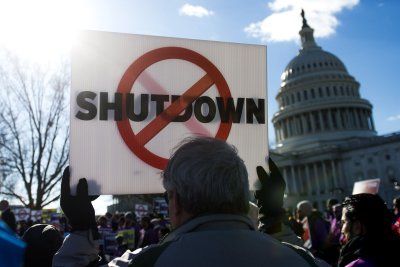
Oct. 18 (UPI) — Senate Democrats and Republicans are not budging on their demands to temporarily fund the federal government and end the shutdown as key dates approach.
The shutdown is the federal government’s third-longest and entered its 18th day on Saturday after the Senate failed to approve a temporary funding measure for the 10th time on Thursday and adjourned for the weekend.
More votes are expected to be held next week, but if the Senate stalemate continues, active federal workers won’t receive their full paychecks on Friday for the first time during the current shutdown, according to The Hill.
Those federal workers who are still on the job also received only partial pay on Oct. 10, which affected an estimated 2 million employees and their families.
Federal workers are guaranteed back pay when the shutdown eventually ends and the government is funded, in accordance with a 2019 federal law.
While active federal workers could miss their first full paychecks on Friday, military personnel are slated to be paid a week later on Oct. 31.
President Donald Trump earlier announced his administration has located $8 billion in unused research-and-development allocations from the 2025 fiscal year that ended on Sept 30.
He used that money to pay 1.2 million military personnel on Wednesday, but several congressional lawmakers question the legality of doing so.
Senate Majority Leader John Thune, R-S.D., intends to hold a vote to pay military personnel and other “excepted” federal workers.
“We’re going to give [senators] a chance to pay the military next week,” Thune told media.
Senate staffers also are slated to be paid on Monday and House staffers on Oct. 31, but the funds are not available.
Another pressing issue is the Affordable Care Act’s annual open enrollment period starting on Nov. 1.
A House-approved continuing resolution that would fund the federal government through Nov. 21 does not include an extension of ACA tax credits, which expire at the end of the year.
The 18-day shutdown will last at least into Monday and only has been surpassed by a 21-day shutdown from Dec. 16, 1995, to Jan. 6, 1996, and a 35-day shutdown that started on Dec. 22, 2018, and lasted until Jan. 25, 2019.
Senate Democrats mostly have refused to approve the continuing resolution and instead offered an alternative funding measure that would fund the federal government through Oct. 31 and would include an extension of the ACA tax credits and Medicaid eligibility.
Senate Republicans mostly prefer to negotiate such things in the 2026 fiscal year budget, though.
Another pressing date is Nov. 21, which is the Friday after Thanksgiving and one of the busiest travel weekends in the United States.
If the shutdown extends into the Thanksgiving weekend, a shortage of air traffic controllers and Transportation Security Administration workers would greatly affect air travel.
The president has cited the shutdown when laying off federal workers, but U.S. District of Northern California Judge Susan Illston has temporarily blocked the Trump administration from continuing to lay off federal workers who are represented by two public sector unions.
On Friday, Illston said she might expand the injunction to include members of three more labor unions, Roll Call reported.
Former President Bill Clinton appointed Illston to the federal bench in 1995.